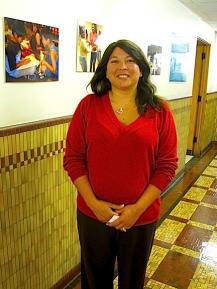






Rachel Byington received recognition this fall as one of four 2011 Women of  Achievement, an award given by the Wisconsin Women of Color Network. She is the Title VII Instructional Resource Teacher for Madison Metropolitan School District (MMSD). Title VII is legislation to support Indian and Alaska Native education.
Achievement, an award given by the Wisconsin Women of Color Network. She is the Title VII Instructional Resource Teacher for Madison Metropolitan School District (MMSD). Title VII is legislation to support Indian and Alaska Native education.
Byington’s involvement in Madison’s community extends beyond her position in the school district. She is on Madison College’s Communities of Color Council, the Wisconsin Indian Education Association board, and the All City American Indian and Alaskan Native Graduation Celebration Committee among other engagements.
Last month, the American Indian Science and Engineering Society (AISES) honored the accomplishments of Madison’s middle school AISES group at their national conference in Minneapolis. The group won their way to the 2011 National Science Bowl competition in Washington D.C. last spring. Byington oversees AISES as one of her many responsibilities for MMSD.
Before driving the science bowl team to Minneapolis, Byington sat down with Madison Commons to discuss her involvement in the school district and the community that led to her Woman of Achievement award.
MC: What is your role in the school district?
RB: I manage the Title VII grant and support students who are Native American and I also do some professional development for our school district as well.
MC: What does a typical workday look for you?
RB: It all depends. It could be meetings, it could be going out to schools. It could be helping a family with specific issues. It could be writing the Title VII grant. It could be looking at data, at student performance; everyday is different.
RB: As with most groups of people, Native people are culurally complex. There are many issues that continue to impact Native students. For example, there are approximately 200 Title VII students in MMSD spread out across 49 different schools. In some cases there might be only a very few Native students in a particular school. To add to that, MMSD has at least 30 different tribes from all over the U.S. so there are students who might feel very isolated. In addition to feeling isolated, Native students may not see themselves represented in the curriculum. We need to do a better job of making sure that all students feel that their identity is a part of their school with classroom materials and lesson plans.
MC: What have you noticed that indicates the students are benefiting from Title VII support?
RB: We have been making gains in graduation numbers, attendance rates, and WKCE scores. We also have a couple of student organizations. One is called American Indian Science and Engineering Society, the other one is called UNITY, United National Indian Tribal Youth. They typically meet on Sundays. Having parents bring their children to an activity on a Sunday, that’s pretty good to have them make sure that they’re not planning activities for their family during that time. Also, we have a core group of parents on the parent committee. The number of parents contacting our program is good, building the relationship, keeping the relationships going. I think that all says a lot. That’s not looking at numbers, that’s looking at people and students and what they’re doing.
MC: What brought you to public education?
RB: My career with public education started indirectly, I was a tutor at an adult basic education lab. Basically most of the people in the class were women that had dropped out at various grades that were looking to either get their HSED or their GED, and I loved it.
I love working with families. I love being able to make a difference. I’m from Madison. I’m Native. I know how it is to be here in the city and be Native. It is a fairly small community of Native people so being able to help people connect with resources that they need. It’s a really good fit for me and being able to make an impact on students, whether they’re non-Native or Native.
MC: What does it mean to be in Madison and be Native?
RB: In some of the larger cities they may have a much bigger population, like Milwaukee. Or Green Bay has a larger population because they have reservations within the vicinity. But there are Native people here. It’s a small community but a thriving community.
MC: What do you see in the future of Madison’s Native community?
RB: I would love to see an Inter-tribal Community Center here. I saw the need for it before my Title VII role and I see it even more now. It would be my dream to help start a center that could help Native people in Madison come together, be proud together and provide support for one another.
|
|
|
Welcome to the Madison Commons, a website designed to provide news and information about all of Madison's neighborhoods and a crossroads for the discussion of community issues. The name comes from the idea of a village commons, a place for news, talk, debate, and some entertainment, too, that's open to everyone.
All rights reserved. Read more about the Madison Commons and its partners.


Comments
Rachel Byington
Congratulations Rachel, you do such good work and you are so good to work with. - Barb